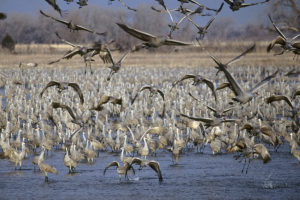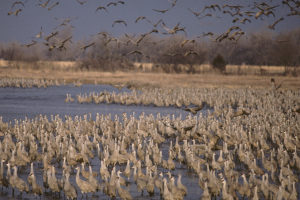Kaj Halberg - writer & photographer
Travels ‐ Landscapes ‐ Wildlife ‐ People
Sandhill cranes – a threat to breeding birds

From the river, we hear a huge chorus of trumpeting sandhill cranes (Antigone canadensis, previously Grus canadensis), but the birds themselves can barely be seen, roosting on sand bars in the river, only about a hundred metres away.
As the rays of the rising sun begin to penetrate the morning mist, the birds take shape, and a fantastic scenery unrolls in front of us. In the shallow waters of the river, about 50,000 cranes are standing shoulder by shoulder. Their trumpeting now intensifies, and the birds begin to shift restlessly, a few performing their graceful dance.
Then, with an incredible crescendo of trumpeting, the birds take flight, flock after flock heading for the surrounding maize fields, where they eat waste kernels, left over from the harvest. For this reason, farmers consider the cranes beneficial, as sprouted maize kernels from the previous year are regarded as weeds.


In former days, the cranes would roost in many prairie rivers, but the majority of these rivers are today regulated by dams, causing most of the sandbars, on which the birds roost, to be either submerged, or covered in dense vegetation, such as willows, because the sandbars are no longer inundated by spring flooding. Along the Platte River, much work is done to clear these thickets, causing about 80% of the world population of sandhill cranes to roost here.
This is the most numerous crane species in the world, numbering more than 700,000, and the population is still increasing, undoubtedly because the cranes have easy access to waste maize.

A sixth subspecies, rowani, is no longer accepted, and some authorities only acknowledge two subspecies, canadensis and tabida. The populations in Mississippi and on Cuba are very small and threatened with extinction.
Northern populations, including the Siberian breeding birds, spend the winter in south-western U.S. and Mexico, whereas the southern populations are resident.
In Nebraska, researchers have found 10-million-year-old skeletal parts of a crane, very similar to the ones of the modern sandhill crane, but probably a different species. However, 2.5-million-year-old subfossils of sandhill cranes have been found, still making it one of the oldest living bird species today.

The cranes are omnivorous, eating whatever they can find: roots and other vegetable matter, insects, mice, and eggs and young of birds.
In later years, several Siberian wader species have declined drastically, mainly due to habitat destruction on their flyways between breeding and wintering grounds. In China, Korea, and Vietnam, huge areas of coastal shallow waters have been converted into shrimp farms, salt pans, or fields – areas, which the migrating waders were dependent on for fattening up, before continuing to their breeding grounds.
Many waders are now in a poor condition, when they arrive in Arctic Siberia, which means that they produce fewer young – or simply skip breeding. Thus, production of chicks has plummeted in many species, and one species, the spoon-billed sandpiper (Eurynorhynchus pygmeus), is critically endangered, with less than a hundred breeding pairs.
Under these circumstances, marauding sandhill cranes really make a difference, and the beautiful birds have become a threat to Siberian breeding waders.



